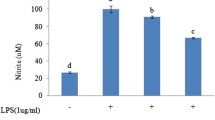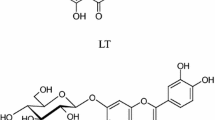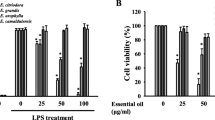Abstract
Pro-inflammatory mediators produced during inflammatory response have been demonstrated to initiate and aggravate pathological development of several chronic diseases. Plant bioactive constituents have been reported to exert anti-inflammatory activities. Various parts of Moringa oleifera have long been used as habitual diets and traditional remedy along the tropical region. Anti-inflammatory activity of boiled M. oleifera pod extract was assessed by measuring pro-inflammatory mediator expression in the lipopolysaccharide-induced murine RAW264.7 macrophage cells. Prior treatment with 31–250 μg/mL M. oleifera extract for 1 h inhibited elevation of mRNA and protein level of interleukine-6, tumor necrosis factor-alpha, inducible nitric oxide synthase, and cyclooxygenease-2, induced by lipopolysaccharide for 24 h in a dose-dependent manner. The suppressive effect was mediated partly by inhibiting phosphorylation of inhibitor kappa B protein and mitogen-activated protein kinases. These results indicate that the anti-inflammatory activity from bioactive compounds present in the M. oleifera pod constituents may contribute to ameliorate the pathogenesis of inflammatory-associated chronic diseases.






Similar content being viewed by others
References
Guha, M., and N. Mackman. 2001. LPS induction of gene expression in human monocytes. Cellular Signalling 13: 85–94.
Ahn, K., and B. Aggrawal. 2005. Transcription factor NF-{kappa}B: a sensor for smoke and stress signals. Annals of the New York Academy of Science 1056: 218–233.
Medzhitov, R. 2008. Origin and physiological roles of inflammation. Nature 454: 428–435.
Aggarwal, B.B. 2004. Nuclear factor-[kappa]B: the enemy within. Cancer Cell 6: 203–208.
Bengmark, S. 2004. Acute and "chronic" phase reaction—a mother of disease. Clinical Nutrition 23: 1256–1266.
FitzGerald, G. 2004. Coxibs and cardiovascular disease. The New England Journal of Medicine 351: 1709–1711.
Gilani, A.H., and R. Atta-ur. 2005. Trends in ethnopharmacology. Journal of Ethnopharmacology 100: 43–49.
Block, G., B. Patterson, and A. Subar. 1992. Fruit, vegetables, and cancer prevention: a review of the epidemiological evidence. Nutrition and Cancer 18: 1–29.
Reddy, L., B. Odhav, and K.D. Bhoola. 2003. Natural products for cancer prevention: a global perspective. Pharmacology & Therapeutics 99: 1–13.
Steinmetz, K., and J. Potter. 1996. Vegetables, fruit, and cancer prevention: a review. Journal of the American Dietetic Association 96: 1027–1039.
Kris-Etherton, P.M., K.D. Hecker, A. Bonanome, S.M. Coval, A.E. Binkoski, K.F. Hilpert, A.E. Griel, and T.D. Etherton. 2002. Bioactive compounds in foods: their role in the prevention of cardiovascular disease and cancer. The American Journal of Medicine 113: 71–88.
Havsteen, B.H. 2002. The biochemistry and medical significance of the flavonoids. Pharmacology & Therapeutics 96: 67–202.
Prasad, S., K. Phromnoi, V.R. Yadav, M.M. Chaturvedi, and B.B. Aggarwal. 2010. Targeting inflammatory pathways by flavonoids for prevention and treatment of cancer. Planta Medica 76: 1044–1063.
Punturee, K., C. Wild, and U. Vinitketkumneun. 2004. Thai medicinal plants modulate nitric oxide and tumor necrosis factor-[alpha] in J774.2 mouse macrophages. Journal of Ethnopharmacology 95: 183–189.
Tuntipopipat, S., C. Muangnoi, and M.L. Failla. 2009. Anti-inflammatory activities of extracts of Thai spices and herbs with lipopolysaccharide-activated RAW 264.7 murine macrophages. Journal of Medicinal Food 12: 1213–1220.
Sae-wong, C., P. Tansakul, and S. Tewtrakul. 2009. Anti-inflammatory mechanism of Kaempferia parviflora in murine macrophage cells (RAW 264.7) and in experimental animals. Journal of Ethnopharmacology 124: 576–580.
Nanasombat, S., and N. Teckchuen. 2009. Antimicrobial, antioxidant and anticancer activities of Thai local vegetables. Journal of Medicinal Plants Research 3: 443–449.
Ramachandran, C., K.V. Peter, and P.K. Gopalakrishnan. 1980. Drumstick (Moringa oleifera): a multipurpose Indian vegetable. Economic Botany 34: 276–283.
Soliman, K.F., and E.A. Mazzio. 1998. In vitro attenuation of nitric oxide production in C6 astrocyte cell culture by various dietary compounds. Proceedings of the Society for Experimental Biology and Medicine 218: 390–397.
Morton, J.F. 1991. The horseradish tree, Moringa pterigosperma (Moringaceae). A boon to arid lands. Economic Botany 45: 318–333.
Anwar, F., S. Latif, M. Ashraf, and A. Gilani. 2007. Moringa oleifera: a food plant with multiple medicinal uses. Phytotherapy Research 21: 17–25.
Amaglo, N.K., R.N. Bennett, R.B. Lo Curto, E.A.S. Rosa, V. Lo Turco, A. Giuffrida, A.L. Curto, F. Crea, and G.M. Timpo. 2010. Profiling selected phytochemicals and nutrients in different tissues of the multipurpose tree Moringa oleifera L., grown in Ghana. Food Chemistry 122: 1047–1054.
Padmarao, P., B.M. Acharya, and T.J. Dennis. 1996. Pharmacognostic study on stembark of Moringa oleifera Lam. Bulletin Medico-Ethno-Botanical Research 17: 141–151.
Faizi, S., B.S. Siddiqui, R. Saleem, K. Aftab, F. Shaheen, and A.H. Gilani. 1998. Hypotensive constituents from the pods of Moringa oleifera. Planta Medica 64: 225–228.
Mahajan, S.G., R.G. Mali, and A.A. Mehta. 2007. Protective effect of ethanolic extract of seeds of Moringa oleifera Lam. against inflammation associated with development of arthritis in rats. Journal of Immunotoxicology 4: 39–47.
Chumark, P., P. Khunawat, Y. Sanvarinda, S. Phornchirasilp, N.P. Morales, L. Phivthong-ngam, P. Ratanachamnong, S. Srisawat, and KuS Pongrapeeporn. 2008. The in vitro and ex vivo antioxidant properties, hypolipidaemic and antiatherosclerotic activities of water extract of Moringa oleifera Lam. leaves. Journal of Ethnopharmacology 116: 439–446.
Mokkhasmit, M., K. Swasdimongkol, W. Ngarmwathana, and U. Permphiphat. 1971. Pharmacological evaluation of Thai medicinal plants. Journal of the Medical Association of Thailand 54: 490–504.
MaAaC, T.N.B.o.A.C.a.F.S. 2006. The amount of food consumption at 95 percentile per capita and eater only. In: Food Consumption Data of Thailand. The Agricultural Co-operative Federation of Thailand Bangkok, Thailand, p 173
Mughal, M.H., G. Ali, P.S. Srivastava, and M. Iqbal. 1999. Improvement of drumstick (Moringa pterygosperma Gaertn.)—a unique source of food and medicine through tissue culture. Hamdard medicus 42: 37–42.
Vichai, V., and K. Kirtikara. 2006. Sulforhodamine B colorimetric assay for cytotoxicity screening. Nature Protocol 1: 1112–1116.
Green, L.C., D.A. Wagner, J. Glogowski, P.L. Skipper, J.S. Wishnok, and S.R. Tannenbaum. 1982. Analysis of nitrate, nitrite, and [15 N]nitrate in biological fluids. Analytical Biochemistry 126: 131–138.
Tuntipopipat, S., C. Muangnoi, P. Chingsuwanrote, M. Parengam, P. Chantravisut, S. Charoenkiatkul and S. Svasti. 2011. Anti-inflammatory activities of red curry paste extract on lipopolysaccharide-activated murine macrophage cell line. Nutrition (in press)
Hommes, D.W., M.P. Peppelenbosch, and S.J.H. van Deventer. 2003. Mitogen activated protein (MAP) kinase signal transduction pathways and novel anti-inflammatory targets. Gut 52: 144–151.
Valledor, A., M. Comalada, L. Santamaría-Babi, J. Lloberas, and A. Celada. 2010. Macrophage proinflammatory activation and deactivation: a question of balance. Advance Immunology 108: 1–20.
Moncada, S., R.M. Palmer, and E.A. Higgs. 1991. Nitric oxide: physiology, pathophysiology, and pharmacology. Pharmocological Review 43: 109–142.
Kolb, J., N. Paul-Eugene, C. Damais, K. Yamaoka, J. Drapier, and B. Dugas. 1994. Interleukin-4 stimulates cGMP production by IFN-gamma-activated human monocytes. Involvement of the nitric oxide synthase pathway. The Journal of Biological Chemistry 269: 9811–9816.
Coleman, J.W. 2001. Nitric oxide in immunity and inflammation. International Immunopharmacology 1: 1397–1406.
Yang, G.-Y., S. Taboada, and J. Liao. 2009. Inflammatory bowel disease: a model of chronic inflammation-induced cancer. Methods in Molecular Biology 511: 193–233.
Chun, O.K., S.J. Chung, and W.O. Song. 2007. Estimated dietary flavonoid intake and major food sources of U.S. adults. The Journal of Nutrition 137: 1244–1252.
Vane, J.R., Y.S. Bakhle, and R.M. Botting. 1998. Cyclooxygenases 1 and 2. Annual Review of Pharmacology and Toxicology 38: 97–120.
Krakauer, T. 2004. Molecular therapeutic targets in inflammation: cyclooxygenase and NF-kappaB. Current Drug Targets. Inflammation and Allergy 3: 317–324.
Pistoia, F., F. Cipollone, C. Ferri, M. Sarà, I. Sudano, and G.B. Desideri. 2010. Cyclooxygenase and atherosclerosis: a smoking area. Current Pharmaceutical Design 16: 2567–2571.
Cerella, C., C. Sobolewski, M. Dicato, and M. Diederich. 2010. Targeting COX-2 expression by natural compounds: a promising alternative strategy to synthetic COX-2 inhibitors for cancer chemoprevention and therapy. Biochemical Pharmacology 80: 1801–1815.
Mikuls, T.R., and K. Saag. 2001. Comorbidity in rheumatoid arthritis. Rheumatic Diseases Clinics of North America 27: 283–303.
Kang, R.Y., J. Freire-Moar, E. Sigal, and C.Q. Chu. 1996. Expression of cyclooxygenase-2 in human and an animal model of rheumatoid arthritis. British Journal of Rheumatology 35: 711–778.
Amin, A.R., M. Attur, R.N. Patel, G.D. Thakker, P.J. Marshall, J. Rediske, S.A. Stuchin, I.R. Patel, and S.B. Abramson. 1997. Superinduction of cyclooxygenase-2 activity in human osteoarthritis-affected cartilage. Influence of nitric oxide. The Journal of Clinical Investigation 99: 1231–1237.
Sano, H., Y. Kawahito, R.L. Wilder, A. Hashiramoto, S. Mukai, K. Asai, S. Kimura, H. Kato, M. Kondo, and T. Hla. 1995. Expression of cyclooxygenase-1 and -2 in human colorectal cancer. Cancer Research 55: 3785–3789.
Tsujii, M., S. Kawano, and R.N. DuBois. 1997. Cyclooxygenase-2 expression in human colon cancer cells increases metastatic potential. Proceedings of the National Academy of Sciences of the United States of America 94: 3336–3340.
Tsujii, M., S. Kawano, S. Tsuji, H. Sawaoka, M. Hori, and R.N. DuBois. 1998. Cyclooxygenase regulates angiogenesis induced by colon cancer cells. Cell 93: 705–716.
Feghali, C.A., and T.M. Wright. 1997. Cytokines in acute and chronic inflammation. Frontiers in Bioscience 1: 12–26.
Chandel, N.S., W.C. Trzyna, D.S. McClintock, and P.T. Schumacker. 2000. Role of oxidants in NF–κB activation and TNF-α gene transcription induced by hypoxia and endotoxin. Journal of Immunology 165: 1013–1021.
Aggarwal, B.B., S. Shishodia, S.K. Sandur, M.K. Pandey, and G. Sethi. 2006. Inflammation and cancer: how hot is the link? Biochemical Pharmacology 72: 1605–1621.
Zhang, X., H. Li, H. Feng, H. Xiong, L. Zhang, Y. Song, L. Yu, and X. Deng. 2009. Valnemulin downregulates nitric oxide, prostaglandin E2, and cytokine production via inhibition of NF-[kappa]B and MAPK activity. International Immunopharmacology 9: 810–816.
Trayhurn, P., and I.S. Wood. 2005. Signaling role of adipose tissue: adipokines and inflammation in obesity. Biochemical Society Transactions 33: 1078–1081.
Choy, E.H., and G.S. Panayi. 2001. Cytokine pathways and joint inflammation in rheumatoid arthritis. The New England Journal of Medicine 344: 907–916.
Tilg, H., and A.R. Moschen. 2006. Adipocytokines: mediators linking adipose tissue, inflammation and immunity. Nature Reviews Immunology 6: 772–783.
Kaplanski, G., V. Marin, F. Montero-Julian, A. Mantovani, and C. Farnarier. 2003. IL-6: a regulator of the transition from neutrophil to monocyte recruitment during inflammation. Trends in Immunology 24: 25–29.
Cronstein, B. 2007. Interleukin-6: a key mediator of systemic and local symptoms in rheumatoid arthritis. Bulletin of the NYU Hospital for Joint Diseases 65: S11–S15.
Pradhan, A.D., J.E. Manson, N. Rifai, J.E. Buring, and P.M. Ridker. 2001. C-Reactive protein, interleukin 6, and risk of developing type 2 diabetes mellitus. Journal of the American Medical Association 286: 327–334.
Hennigan, S., and A. Kavanaugh. 2008. Interleukin-6 inhibitors in the treatment of rheumatoid arthritis. Ther Clin Risk Manag 4: 767–775.
Hodge, D.R., E.M. Hurt, and W.L. Farrar. 2005. The role of IL-6 and STAT3 in inflammation and cancer. European Journal of Cancer 41: 2502–2512.
Drachenberg, D.E., A.-A.A. Elgamal, R. Rowbotham, M. Peterson, and G.P. Murphy. 1999. Circulating levels of interleukin-6 in patients with hormone refractory prostate cancer. The Prostate 41: 127–133.
Tak, P.P., and G.S. Firestein. 2001. NF–κB: a key role in inflammatory diseases. The Journal of Clinical Investigation 107: 7–11.
Epstein, F.H., P.J. Barnes, and M. Karin. 1997. Nuclear factor-κB—a pivotal transcription factor in chronic inflammatory diseases. The New England Journal of Medicine 336: 1066–1071.
Sethi, G., and V. Tergaonkar. 2009. Potential pharmacological control of the NF-[kappa]B pathway. Trends in Pharmacological Sciences 30: 313–321.
Chang, L., and M. Karin. 2001. Mammalian MAP kinase signalling cascades. Nature 410: 37–40.
Kaminska, B. 2005. MAPK signalling pathways as molecular targets for anti-inflammatory therapy–from molecular mechanisms to therapeutic benefits. Biochimica et Biophysica Acta 1754: 253–262.
Kim, E.K., and E.-J. Choi. 2010. Pathological roles of MAPK signaling pathways in human diseases. Biochimica et Biophysica Acta (BBA) - Molecular Basis of Disease 1802: 396–405.
Acknowledgment
This study was supported by National Science and Technology Development Agency, Thailand. The authors thank Dr. Harold C. Furr for his helpful commentary during manuscript preparation.
Author information
Authors and Affiliations
Corresponding author
Rights and permissions
About this article
Cite this article
Muangnoi, C., Chingsuwanrote, P., Praengamthanachoti, P. et al. Moringa oleifera Pod Inhibits Inflammatory Mediator Production by Lipopolysaccharide-Stimulated RAW 264.7 Murine Macrophage Cell Lines. Inflammation 35, 445–455 (2012). https://doi.org/10.1007/s10753-011-9334-4
Published:
Issue Date:
DOI: https://doi.org/10.1007/s10753-011-9334-4




